The following is a sampling of items from this year's live auction on Saturday, May 21.
"The objects from Africa that will be presented at the Anansi auction are not tourist decorations. They are real tribal pieces of high museum quality. They are objects that a serious collector of tribal art would want in a private collection. Several of them are old pieces from the early 20th century from the tribes in and around the Ashanti, Yoruba, Senufo, N'gere and Dan tribes and other groups from that area and have the traditional characteristics of the objects used there ritually. Katherine Roe has selected a beautiful set of figures and masks, large and small, for the auction and serious collectors of tribal arts should attend."
 |
Brass Armlet
This is a beautiful, old Lobi brass arm bracelet. Made in the lost wax method, the cast brass shows an unusual intricacy of design and heft that has a tremendous sculptural three dimensionality. Wear it on your arm or hang it on your wall!
(3.5” x 5”) |
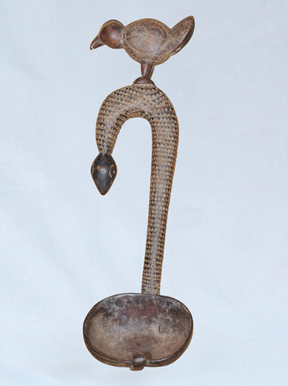 |
Carved Spoon
This wonderful large Ashanti wooden spoon is old and has been used. It presents a snake and bird in combination with the spoon bowl to create a composition of elements that is quite charming and elegant. The incised pattern of the snakeskin creates a great repetitive texture and contrast to the rounded smooth form of the bird as they dance their dance with each other. Cultures round the world and through time have decorated the functional items of their daily life.
(6" x 15.5") |
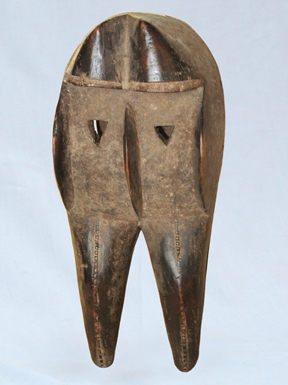 |
Double Cubist Kaogle Mask
The ‘Cubist’ Kaogle masks of the Dan People in Cote d’ Ivoire are characterized by protruding disc-like cheek bones, triangular eyes, and an overhanging brow. This form of Kaogle mask typically represents chimpanzees, crocodiles, or birds. The term ‘cubist’ is used to describe this style because of the strong influence it had on Pablo Picasso, who began collecting Ivorian masks in 1907 and gathered over 100 pieces of African art during his life.
(9” x 19”) |
 |
Colonial Spirit Spouse
This modern spirit spouse representing "Other Worldly Spouses", called the "blolo bian" for a man or "blolo bia" for a female, reflect an artistic tradition of the Baule people. The tradition is born of the belief that the spirit world exists parallel to our world and that we have a spouse within that spirit world that requires our attention and care. If there are troubles within your relationship in this world, it could be that you are not attending to the needs of that relationship in your spirit world. In practice, an individual commissions from a carver a representation of his or her spirit spouse. This carving of a modern man is a continuation of this long tradition but reflects the influence of colonialism and globalization. This carved figure would be kept in the home and “fed and cared for” to insure the wellness of all. While these carvings are not created as “art” defined by a Western conception, their aesthetically pleasing forms make them visually appealing and intellectually interesting to contemplate. This piece was donated to Anansi by Traore Yakubu, owner of Mokome Enterprise at Art Center No. 26 in Accra.
(6.5" x 39") |
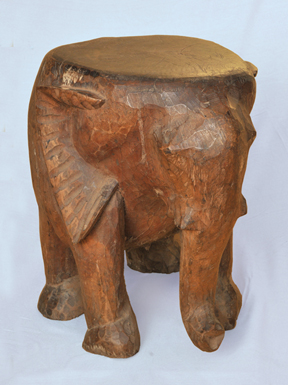 |
Elephant Stool
This is an old Senufo elephant stool, from Cote d’Ivoire, that is a traditional form and due to it’s age is of increased value. It is wonderfully expressive and a delightful form upon which to sit. The wood is dense and weighty and the warm wood tones are beautiful. It is easy to see the growth rings of the tree and get a sense of it’s age and use.
(10” x 15” x 14.5”) |
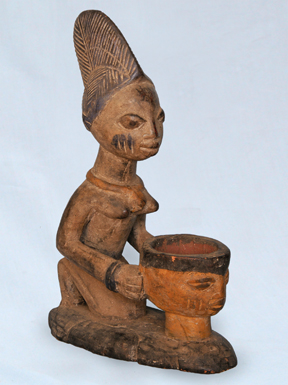 |
Yoruba Figural Offering Bowl
This form, with a kneeling female figure with lidded bowl, is known as an Opon Igede Ifa." Would tranditionally have chicken lid This Nigerian figurine depicts Oko,a Yoruba orisha, or diety, associated with farming. The sculpture of a woman with a bowl symbolized the fertility of the land. Orisha is the collective name for the many divinities of the West African Yoruba religion, which has one of the most complex pantheons in Africa. The orisha are often characterized both as nature spirits and as historical figures. "Bowls like these were used to hold kola nuts as offerings of hospitality or as receptacles for the sixteen sacred palm nuts used in divination.
(12.5" x 17.5") |
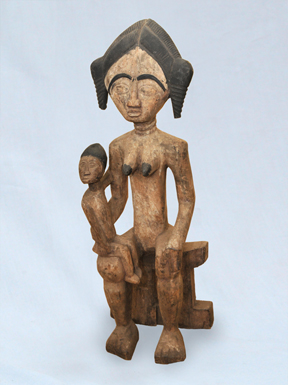 |
Fanti Maternity Figure
This seated female figure with child, carved by a Fanti of the Akan people is classic in his subject matter and like many such sculptures reflects and ideal sense of beauty. It is more primitive in style but there is an imposing directness to this one that becomes more endearing with time.
(11" x 30.5") |
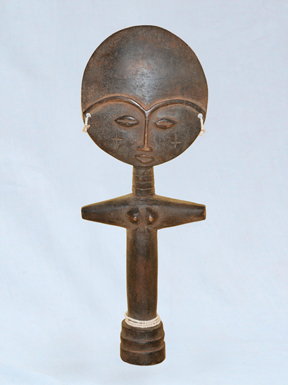 |
Ashanti Fertility Doll
The fertility doll, called Akua’ba or “Child of Akua”, as a sculptural form is one of the more familiar to the Western eye. Carved figures like these were carried by girls and women to promote their fertility, and to ensure the beauty and health of their offspring. The round, flat disc heads, columnar body with outstretch arms and smooth black surface convey the Ashanti ideal of beauty. Exceptionally well crafted and an old piece, this is the finest Ashanti Fertility Doll that Anansi has offered in any auction.
(5" x 13") |
 |
"Stitched" Dan Mask
This is an old and beautiful example of a female Dan mask that was obviously carved by a master carver. The high rounded forehead and realistic portrayal of the facial features is characteristic of Dan masks. The female mask is designated by the slit eyes, as opposed to a round eye presentation, if the mask were that of a male. The hair portrayal is a lovely detail not commonly seen. The Dan people have lived in Cote D’Ivoire and Liberia since the 8th century BC. The mask is old enough that the repair is made with leather thong stitching as opposed to being glued (a more common solution recently).
(5.75" x 9") |
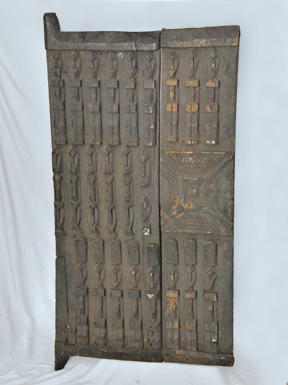 |
Dogon Door
This carved wooden panel is traditional with the Dogon people that live in Mauli along the Bandiagara Escarpment.
These doors are installed to protect the window like openings into each family’s grain storage. They are carved in low relief, often of dancing figures that represent the ancestors. The spirit, Lebe, is represented by the zigzagging motif in the lock area on the door and is believed to be the mainspring of germination and the source of vital life force. The pegs on one side of the panel are part of the hinge mechanism as it was set into the building.
(19.5" x 38.5") |
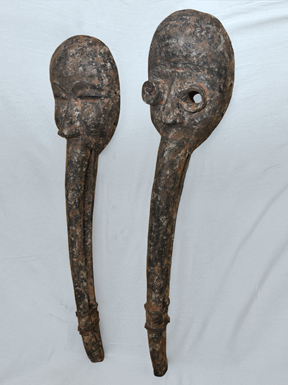 |
Old Dan Bird Masks
This amazing pair of masks are part of the mask tradition of the Poro Society in Dan culture. In the Poro Society female masks (identified by their narrow eyes) are largely used in entertainment dances, while male masks (with rounded eyes) are used by male dancers from their rites of passage onward in ceremonial dances.
The heavily encrusted surfaces attest to their use and age.
(8” x 33” and 8” x 32”) |
 |
Anansi Storybook Reading by Chris Ensweiler
What better introduction to Anansi stories than a private reading from “The Adventures of Spider” — a collection of stories centering around the mischievous hero of Ghanaian folklore. Chris Ensweiler is a classic actor who performs regularly for Seattle Shakespeare Company. Schedule based on mutual availability.
|
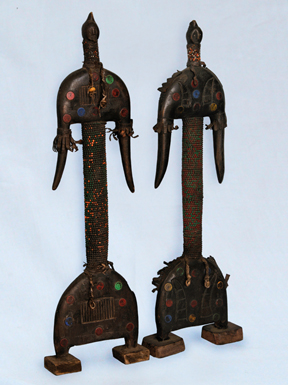 |
Namji Dolls
These large doll-like figures from Camaroon were used for ritual purposes, as a protective fetish figure with beads and magical additions, or, in simpler pieces, as a fertility figure for young women.
(24.5” tall)
|
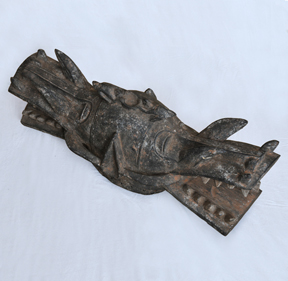 |
Kponyungo "Fire Spitter" Mask
Kponyungo masks typically combine the features of animals associated with power and bravery — crocodiles, warthogs, buffalo, hornbill birds, or chameleons. They are used in anti-witchcraft dances to engage and vanquish evil forces, ensuring a period of spiritual safety for the community.
|
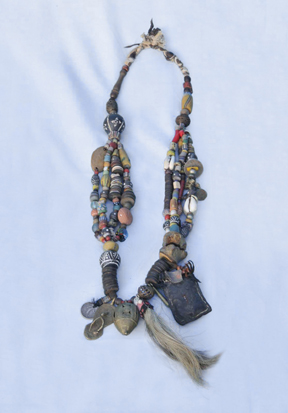 |
"Crafty" Necklace
Arimiyao Issifu, known to us as “Crafty”, a long time friend of Anansi from Ho, Ghana made this large necklace, appropriate for a man or a woman, with his typical aplomb. What makes Crafty’s work so special is his creative approach to traditional West African aestetics. The eclectic and even cluttered style of this piece is typical of the style favored by shamans in Ghana and surrounding countries.
|















